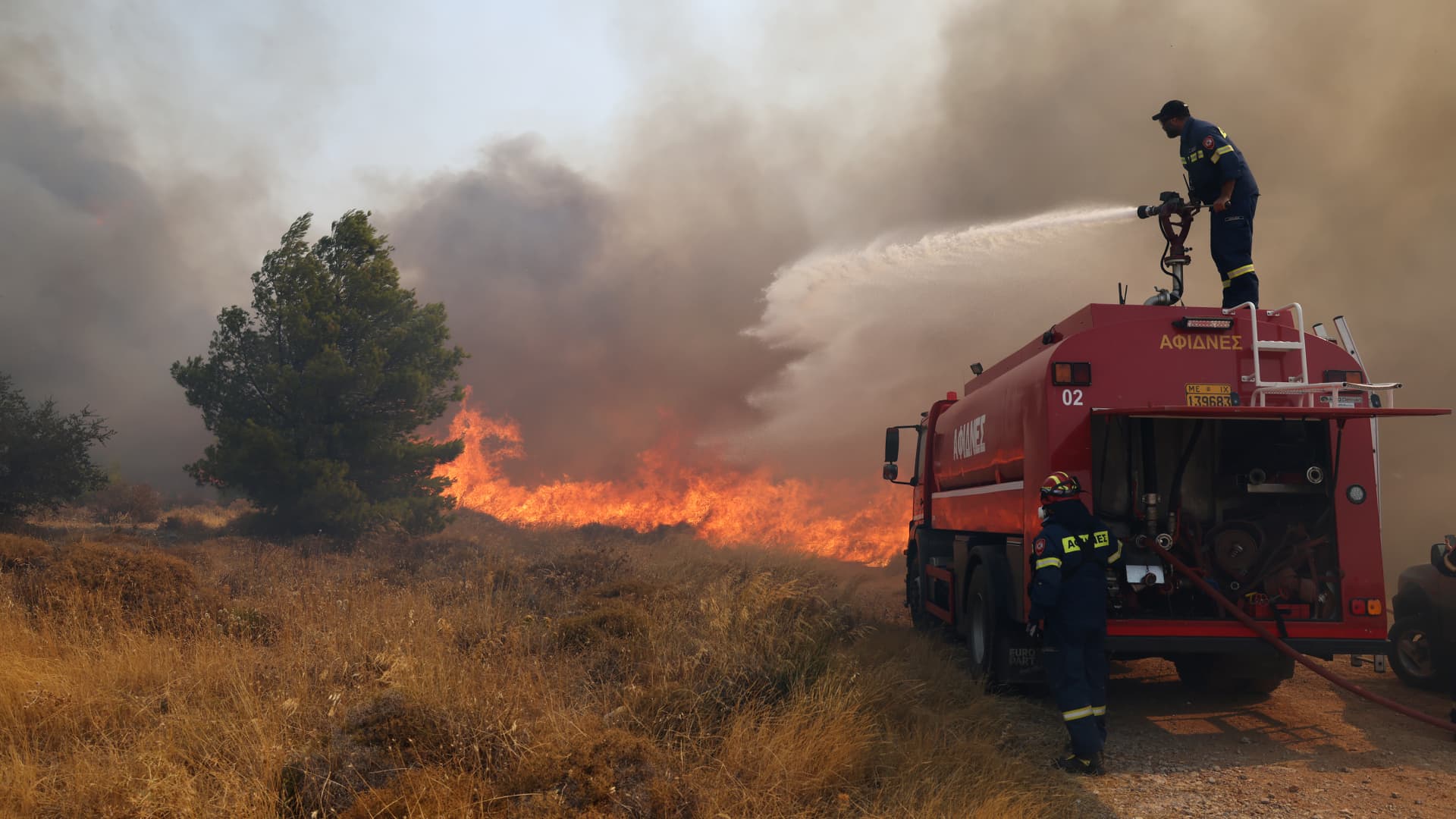A Sikorsky S-64 Skycrane drops water over a house during a wildfire spreading in Acharnes, north of Athens, on August 23, 2023. Greek firefighters on August 23, 2023 struggled to contain uncontrolled fires throughout the country for a fifth day, several of them bordering an acrid, smoke-filled Athens.
Angelos Tzortzinis | Afp | Getty Images
Europe is in the grip of a summer of climate-fueled extremes, with countries across the continent struggling to cope with the ramifications of searing temperatures, raging wildfires and devastating floods.
In just the last few days, firefighters in Greece have battled to contain a blaze destroying homes near the capital of Athens, French power producer EDF said nuclear output cuts were likely over the weekend due to a spell of excessive heat, Italy issued health warnings over “emergency conditions,” and Turkish authorities briefly closed a strategically important waterway to clear an area for planes fighting nearby forest fires.
Meanwhile, Norway, which has suffered from heavy rainfall, floods and landslides in recent weeks, is once again under a top-level red alert for rain in the southern part of the country.
Europe’s protracted battle with extreme weather conditions comes shortly after official data showed July was the hottest month in history. To be sure, the climate emergency — which is primarily driven by the burning of fossil fuels — is making extreme weather and its impacts more frequent and more intense.
“This is the new normal and does not come as a surprise,” said Alvaro Silva, a climate expert with the U.N.’s World Meteorological Organization.
People stand at an overflooded petrol station in Gjovik on August 11, 2023 after extreme weather with heavy rain hit south-east Norway.
Heiko Junge | Afp | Getty Images
“The frequency and intensity of many extremes, such as heatwaves and heavy precipitation, have increased in recent decades,” Silva said in a statement published Tuesday.
“There is high confidence that human induced climate change from greenhouse emissions, is the main driver. This gives us the long-term context for the increasing occurrence and severity of such extreme weather and extreme events.”
‘Another blow for glaciers’
In Greece, wildfires raged near the capital of Athens for a second consecutive day on Wednesday and authorities have warned that scorching heat and strong winds could fuel a new spate of blazes in the coming days. The blazes have led to a number of reported deaths nationwide.
Firefighters on Tuesday found the burnt bodies of 18 people believed to have been migrants who had crossed the Turkish border near the northeastern city of Alexandroupolis. Two people died and two firefighters were injured in separate fires on Monday.
In France, power company EDF said Monday that it would likely need to reduce nuclear output over the coming weekend as a punishing heatwave baking large parts of the country warms rivers used for cooling some of its reactors.
On the same day, France issued an extreme heat warning for four regional departments in the southern regions of Rhone, Drome, Ardeche and Haute-Loire.
A homeless man begs for money in a street of Bordeaux, southwestern France on August 24, 2023, as a heatwave sweeps across France.
Christophe Archambault | Afp | Getty Images
In Italy, authorities have issued red alert “emergency conditions,” which means that even those that are healthy are at risk of adverse effects from the extreme heat. Temperatures on Friday are expected to peak at around 40 degrees Celsius (104 Fahrenheit) in the inland areas of Sardinia, according to Italian weather news service Meteo.it.
The forecasting website said the exceptional heat is due to an anticyclone known as Nero. Heavy thunderstorms and “sudden drops in temperatures” are expected from Saturday, however.
Turkish authorities said Wednesday that shipping on the Dardanelles Strait would partially reopen after firefighters halted the spread of a nearby two-day forest fire in the northwest of the country.
The suspension of vessels traversing the shipping route, which connects the Aegean Sea and the Black Sea, was ordered to allow helicopters and planes to scoop up water to douse the blaze, Reuters reported.
The heat has reached new heights in Switzerland, too. The central European country on Monday reported a new record for the so-called zero-degree Celsius line, a key meteorological marker in mountainous regions that reflects the altitude at which the temperature falls below freezing.
Little snow cover and glaciers melting at an alarming rate amid Europe’s sweltering heatwaves have put some of the most classic Alpine hiking routes off-limits. Usually at the height of summer, tourists flock to the Alps and seek out well-trodden paths up to some of Europe’s most iconic peaks.
Fabrice Coffrini | Afp | Getty Images
The Swiss weather service said Monday that readings from its weather balloons showed the zero-degree line in Payerne in western Switzerland had climbed to a high of 5,298 meters (17,381 feet) above sea level.
It is the highest level since records began nearly 70 years ago and surpasses a previous record that was only set in July last year.
“Another blow for glaciers that have already strongly suffered this year. Snow coverage is only present at the highest elevations,” said Matthias Huss, head of Switzerland’s glacier monitoring network and a member of WMO’s Global Cryosphere Watch community.





















Discussion about this post